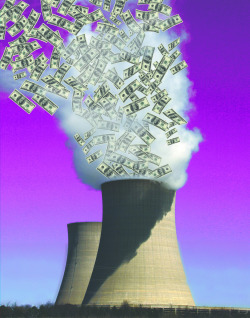 As reported by Bloomberg Government's Mark Drajem, Edward Kee, the founder of the Nuclear Economics Consulting Group, has a not so modest proposal to "save the nukes": a federal government bailout, or outright takeover, akin to the $700 billion rescue package for Wall Street banks and the Big Three automakers in the aftermath of the 2008 U.S. economic crisis.
As reported by Bloomberg Government's Mark Drajem, Edward Kee, the founder of the Nuclear Economics Consulting Group, has a not so modest proposal to "save the nukes": a federal government bailout, or outright takeover, akin to the $700 billion rescue package for Wall Street banks and the Big Three automakers in the aftermath of the 2008 U.S. economic crisis.
Of course, Kee's outrageous scheme seems to forget, the U.S. government -- that is, federal taxpayers -- as well as electric ratepayers, have been subsidizing nuclear power for decades, to the tune of tens or even hundreds of billions of dollars, as Doug Koplow documented in a comprehensive 2011 report commissioned by the Union of Concerned Scientists.
But then again, Amory Lovins of the Rocky Mountain Institute made the astute observation, many years ago, that the only places where nuclear power is enjoying a significant growth spurt, are in countries with highly centralized economies, such as China and India.
That is, the public pays, while the nuclear robber barons profit.
The small number of reactors under construction in the U.S. operate along the same lines. The two new reactors under construction in Georgia -- Vogtle Units 3 and 4 -- enjoy not only ratepayer subsidies dubbed "Construction Work in Progress," or "advanced recovery" surcharges on electric bills, but also $8.3 billion in federal taxpayer nuclear loan guarantees, compliments of the Obama administration.
The two new reactors under construction in South Carolina -- Summer 3 and 4 -- have foregone federal loan guarantees, instead doubling down on gouging ratepayers. Remarkably, one-fifth of South Carolina ratepayer electric bills now go towards building the two reactors, after the ninth "pay-in-advance" rate hike, in just the past several years, as reported by the Charleston, South Carolina Post & Courier.
And the latest nuclear establishment fad -- so-called Small Modular Reactors (SMRs) -- have also enjoyed many hundreds of millions of dollars of federal taxpayer subsidization, a trend that will continue, if the national nuclear labs, reactor vendors, and nuclear utilities of the U.S. continue to get their way.
Kee's immodest proposal also seems to forget that nuclear industry lobbyists, as from Exelon and Entergy, demanded competitive electricity markets back in the 1990s and early 2000s. They hoped to make even more profits than they were already making under regulated monopolies that they then enjoyed. Now that atomic reactors can't compete with cheaper sources of electricity, in the markets their own lobbyists demanded be created, nuclear utilities are crying foul, and demanding the clocks be turned back, and their profits again guaranteed, at ratepayer expense.
The proposal for government takeover of failing atomic reactors extends from the federal level to the state level. As reported by Syracuse.com, in New York State, for example, local elected officials, nuclear power plant unions, and a former Republican Public Service Commission chairman have called for the State of New York Power Authority to take back over at Entergy's FitzPatrick, scheduled to close in January 2017. Democratic Governor Andrew Cuomo has rejected that idea, although he does support ratepayer subsidies in the form of "zero emissions credits" under the Public Service Commission's Clean Energy Fund program, in development. Groups like NIRS and AGREE have led the resistance to that particular form of bailout, which would burden New York ratepayers to the tune of billions of dollars over time.





 June 30, 2016
June 30, 2016
